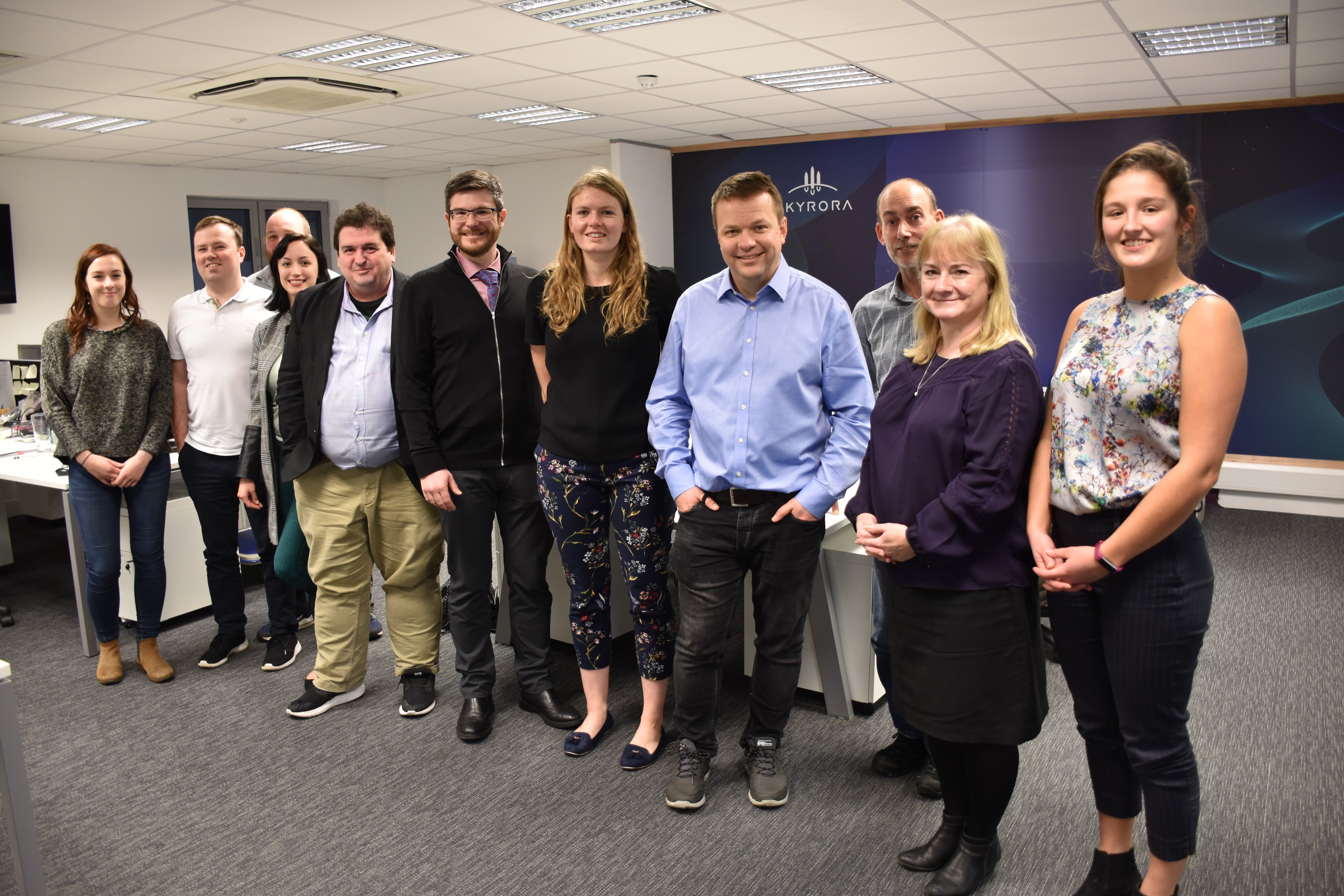“More investment in launcher capabilities is needed in Europe”
Interview with Volodymyr Levykin, CEO of private launch service company Skyrora Ltd.
Skyrora represents a new breed of private rocket companies developing the next generation of launch vehicles for the burgeoning small satellite market. Official forecasts predict that there will be around 11.000 ‘small sats’ launched worldwide over the next five years with payloads of up to 300kg launched to 500km altitude. This has triggered a demand for smaller and more cost-effective launchers and launch services. Currently, the private launch vehicle community is a nascent New Space market with a handful of players, dominated by big names in the US such as Space X with its Falcon 9 launcher and Virgin Orbit’s Launcher One rocket. Other US-based players include Firefly Aerospace, Vector and Rocket Lab with investment fuelled by the huge American Space Programme and NASA missions as well as big VC investors. In Europe, the private launcher sector is somewhat more moderate, but inroads have been made by PLD in Spain and the British/Danish venture Orbex. With Edinburgh-based Skyrora a third player emerged in 2017, which has its first rocket engine test under its belt already, conducted in July of last year.
Spaceoneers caught up with the fast-moving CEO of Skyrora, Volodomyr Levykin, at its headquarters in Edinburgh.
Q: After years of running an IT company, what inspired you to become a Space entrepreneur?
A lot of IT guys started to invest in space, so I became interested too, but I also wanted to do it successfully, more effectively, with less money.
Q: Skyrora is not exactly a typical start-up – you’ve been around for only 18 months, but you already have a headcount of about 130 people and invested 3.7 million GBP yourself to date. How important is it to move fast in the private launcher market and what’s next for you?
I invested myself as a founder, because we really needed to kickstart this venture fast. We also knew we needed a strong team from day one. That is why we hired a number of experienced engineers in the Ukraine and the UK. In addition to the British space technology experience, I hired Ukrainian engineers, because there is an excellent heritage and skill set there, which also comes with economic benefits as the cost structure is different. So, we invested a significant sum of money ourselves, added some loans, and now we’ve found several potential investment partners who may co-invest. Going forward, we are actively seeking further investment to hit the next milestones.

Q: What is your timeframe for your current fundraise and how will you invest that money? What are important milestones?
We are looking to close our funding rounds by the early 2020s.
We now have a fantastic opportunity in the market, if we can keep up the pace. Our next big milestone is to develop the SK1 suborbital rocket as well as launching two more of our trial rockets from Scotland. This is crucial for all further orbital rocket development.
Q: When do you expect your first commercial launch to take place?
All our launches are and will be commercial, even the small test launches. Even our first launch was commercial with a payload from a European IT company. The first larger-scale commercial launch will take place after at least two test launches. Rocket Lab did two launches that weren’t commercial and only the third one was partly commercial. I would expect our first larger commercial launch in about 2024/2025. In the meantime, we will treat every launch as a standalone commercial opportunity.
Q: Where do you think commercial prices for payloads have to go to be economically viable in this emerging market for small satellite launches? And where do launch costs have to arrive at for launch companies to create viable business models?
First of all, I want to increase the attractiveness of our business by not only offering a reliable and responsive launcher, but the whole service package around it, such as documentation and legal support required for the testing. We want to be a one-stop shop for our small sat customers, a responsive service business.
We are going to charge market prices, not moving the price dramatically down, because rockets are expensive. The price as it currently stands is about GBP 30,000 per kg of payload. The current market price in the US is about US$ 50,000 per kg. Don’t be misled by the price per kg on large launchers on which you can launch several small sats in one go. Commercially, for the smaller satellite companies, it would still be cheaper to put their payload on a rideshare with larger launchers, as the price per kg is lower on these. The larger the vehicle, the lower the profit margin per kilo. It is the same as sending a parcel to America. You can send it by sea in a large container and wait for six months, but it will be relatively cheap as a price per kilo. Or you can send it by air – you will get the job done in a couple of days, but the price per kg will be much higher and you are also limited on the size of the package. So, the sea container is an analogy for the big launcher as the satellite companies have to wait for the next big launch to come along. We are the rocket equivalent of sending the package by air express.
Q: What type of customers are your prime target initially?
There are a number of private satellite companies that build spacecraft in the range of 50-300kg. So, potentially payloads of 300kg, maybe even 400kg.
Q: What are typical applications for these smaller satellites?
Scotland is good for applications for the polar and sun-synchronous orbits, which are the main orbits for all kinds of small sats relying on grids of satellites. The equator is good for the geostationary orbit and also usually an ideal place for the large space crafts and their applications such as GPS, weather and telecommunications. But these are the old school players. The small sats have to rely on a grid approach, they need to send up hundreds of sats and they prefer the orbits we can launch to from Scotland.
Q: Talking about Scotland – tell me about the challenges of establishing the Space Port, a new launch site in Scotland.
We are not building it, but yes, it is important infrastructure. Geography-wise, Scotland is a good location. It has clean trajectories, which means you don’t have to do complicated manoeuvres, for example the requirement to avoid populated areas on the way up and when the rocket drops the stages. Scotland is a good location, one of the best we have in Europe, I think.
Q: What about environmental concerns, Government regulations and other potential hurdles? What is your biggest challenge at the moment?
Our biggest challenge are regulations. The required regulations for the launch of smaller sats have simply not been released, there has been a delay. On the positive side, the UK is one of the first countries in Europe that has started this process, the UK Space Agency is leading the way here.
Q: Would it be an option for you to help develop other European launch sites, for example in Norway, to increase the number of launch sites in Europe?
We are focusing on the UK and continental Europe. Our main focus at the moment is the development of a Scottish Space Port, but we also have very good connections with Andorra and Norway as well as Esrange in Sweden. We are exploring the Azores islands as well as a potential Portuguese space port location. Everyone wants to launch our rockets as tests from their location. It is a great PR case and exercise for them to get launch experience and learn how to do checks for future licenses. However, we only have two rockets to be launched at the moment (laughs).
Q: Not many start-ups have attempted to build rockets, Skyrora is one of the first of its kind. You build most of your technology in-house – what is your thinking behind this strategy?
Right now we are in R&D stage, which means we are learning how to do things, how to use new materials and technologies, modern production techniques. If a large aerospace company would do the R&D for us, it would cost us 10-20 times more than doing it on our own. In the future, when we come to mass production stage, I would expect to team up with large companies with experience in how to mass-produce. It’s a different exercise to move costs down in mass production. We will come to the industry with a ready-made solution that can go straight into production. We are already in discussion with larger space companies and they really like this idea, because they have the facilities, experience and people for mass production. They might not necessarily have any rocket experience, but the factories and manufacturing capabilities needed in this area are there.
Q: What role does 3-D printing play in your production process?
We are relying on 3-D printing especially with regard to the prototyping stage of our Leo engine. It will allow us to build our engine much faster at a lower cost compared to the ordinary way of designing the engine. However, the final item is still too expensive at the moment, because it is a prototype, not mass production. In later stages, we are planning to replace 3-D printing with other ways of manufacturing, more suitable for the mass production line.
Rockets are made of engines, tanks and computers. The tanks we build in-house are currently going through high pressure testing. We also build the test facilities in-house, which is very important. We are currently looking for engine testing facilities in the Edinburgh area, which is a challenge. We also managed to build a synthetic fuel in-house and distill the hydrogen peroxide, which is our oxidiser, in-house. That enabled us to reduce the oxidiser price from 10 Euro to 2 Euro per kg, which is significant. It is also more cost-effective to transport low-grade fuel and upgrade it at the test site.
Computers are another element of the most advanced part of the vehicle, which we also develop in-house as we have a lot of IT know how. Valves are another challenge, a very important part of engineering, which we do both in-house and offsite.
Q: Are you also conducting research into new materials?
As a new company we have no legacy when it comes to developing and using new materials. For an established company like Ariane Group, who has hundreds of launchers, it’s a great challenge to change any material in their design. It is very expensive, you need to consider insurance and regulatory aspects, that it is still safe to fly, new licenses. That is why the aerospace industry is very conservative. As a start-up, we don’t have to be conservative, we have the opportunity to try different materials. This extends to materials freely available in the market, which has for example enabled us to reduce the weight of our airframe by 50%. We also know that all our competitors and partners are dealing with the same challenges, for example that additive manufacturing is not mature enough yet, is very expensive, and regulations are not in place.
The real threat will come from new competitors that are yet to emerge – they will learn from us as we learn from the incumbent industry players. Now is the time we need to invest in new materials and technologies in order to compete with future competitors.
Q: What differentiates Skyrora from more established New Space companies such as Firefly, Vector and PLD and also the future ones? What do you have to do to stay ahead of the competition?
We do have quite a few technological advantages. One unique aspect is our Hydrogen Peroxide oxidiser, which is storable, which means the rocket can be fuelled and wait for the launch part for a much longer time. It can be launched horizontally and vertically, which is also a key part.
Furthermore, we have a three-stages design, the last one is re-ignitable to do manoeuvres in space, to deploy payloads in an exact position. The third stage is all about more gentle lift-off, less stress for the payload. But we are also focusing on offering supplementary services, building a one-stop shop for small space crafts from day one.
Another way we will stay ahead of future competition is by investing in new materials. Our experts in the UK and the Ukraine have started our first foray into new materials and alloys. We are conducting research into structures that have recently been discovered, such as carbon nanotubes and titanium, for use in our vehicles.
Q: What is your message to investors as to why they should become involved at this early stage? What are the potential payoffs? Why should they get on board now?
First of all, I would like to point out the disproportionate investment situation in the UK – a lot of money has been invested in satellites and not enough in launcher capabilities, which is creating a bottle neck. In order to secure the investments they have made in satellites, investors need to keep an eye on the launch market if they are serious about the space sector. Rockets are enablers for other investments.
Investing in us now means joining a fast-moving company, an enabler in the new space market, who tracks what is going on in the sector. Space is about a revolution in the future, it’s an exciting journey. We are pioneers and the feeling, when a rocket takes off, is a great feeling, especially when you realise you are part of this initiative. After years of running IT companies, this is still a completely different level of personal satisfaction.

